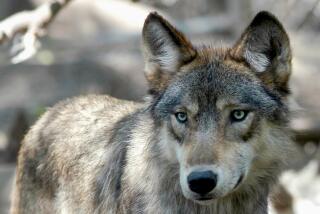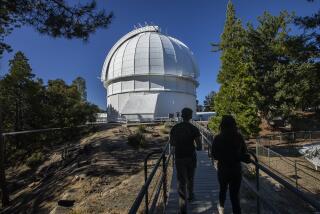Pursuit of Science in the Rockies : Researchers Conduct Studies in a Harsh Environment
- Share via
NIWOT RIDGE, Colo. — Botanist Oren Pollak lay on his stomach starring intently at the dazzling white puffball flowers growing on this 11,300-foot-high, wind-swept ridge in the Colorado Rockies.
“These American bistorts could be the longest-lived small plants on Earth,” said the 26-year-old scientist spending his third summer studying and dating plants able to survive in tundra above the tree line, one of the harshest environments in the world.
Pollak, of Sherman Oaks, Calif., is the first person to study bistort longevity. He discovered that the plant’s caudex (it’s underground woody stem) is scarred with each leaf of its existence, providing a dating record similar to tree rings.
American bistorts at this elevation grow an average of four leaves a year. The oldest plant Pollak has dated so far is 74. At lower elevations the life spans of bistorts are much less, half that at 9,500 feet in the meadows near the University of Colorado’s 71-year-old High Mountain Research Station, Pollak’s base of operation.
“I began my studies of American bistorts by mapping populations. When I checked my study plots the second year, I could not believe what I was seeing. Something was wrong, I thought. None of the bistorts were dying as other plants were,” Pollak recalled. Then he discovered his dating process.
Up Niwot Ridge, a few hundred yards from Pollak, another researcher from the high mountain station, Rick Brown, of Davis, Calif., was weighing a round-eared cousin of the rabbit, a pika, one of few animals found at this elevation of 11,900 feet.
Apples Used as Bait
Brown, 26, traps pikas for his studies using apples as bait, marking the mammals with ear tags for identification. He weighs them in a plastic bag while using a small hand-held scale. He has spent the last four summers studying the tail-less mammals and has been bitten at least 100 times by the feisty, little critters measuring four or five inches long.
Pikas dwell in large rock piles above the tree line on the slopes of steep Niwot Ridge located five miles east of the Continental Divide.
“It’s like working on top of the world. Incredible view, isn’t it?” said Brown looking out over miles of spectacular snow-covered towering mountains. “We get lightning strikes almost every afternoon up here. Lightning bounces all over the place. Scares the hell out of me. Scares everybody with any sense,” he said.
Serenade of Squeaks
One always knows when pikas are close by from the serenade of their delightful squeaks. Like the American bistorts, pikas are long-lived. With an average life span of six years, they live twice as long as their cousins at lower elevations.
To survive through the fierce winters, American bistorts in the high elevations of the Colorado Rockies produce salts and proteins, their own form of antifreeze to prevent them from freezing.
Pikas are active year-round and do not hibernate like other small mammals. Pikas spend the summer harvesting flowers, grasses and other plants, stashing them in hay piles in rocks for winter food supplies.
Brown and Pollak are among more than 100 scientists and graduate students doing research this summer at the University of Colorado’s High Mountain Research Station 25 miles west of the Boulder campus, five miles north of the hamlet of Nederland.
The scientific station, at an elevation of 9,500 feet, is the oldest and largest year-round high-altitude research center in America, one of the oldest and largest centers of its kind in the world. Alpine textbooks have been written entirely from studies conducted here beginning in 1914. Scientists call the mountains surrounding the station “the best-known piece of alpine real estate in the world for research.”
Scientists come here year-round from all over the nation, from all over the world.
Pat Webber, 47, UC Boulder professor of environmental biology, has spent several months each of the past 17 years doing research here. For the past six years he has been director of the University of Colorado’s Institute of Arctic and Alpine Research (INSTAAR), the scientific group that runs the station.
“Scientists use this mountain station as their base,” explained Webber. “From here they go out into the field to the tundra country above the tree line in four-wheel-drive vehicles and snowmobiles to conduct their studies in environmental sciences, biology, geography, geology and all the various disciplines pertaining to alpine research.
Built by Professors
“These log cabins, clustered around lab buildings, are used for housing; they were constructed by the professors themselves in the early days of the station.”
The station is one of 11 ecological research centers in America sponsored by the National Science Foundation. The foundation currently provides $300,000 a year for the center’s research programs. Watershed experiments conducted here in the early part of the century were among the first ecosystems studied anywhere on Earth.
Webber said Soviet scientists visited the station in 1974 and photographed everything in sight. “Five years later I was invited to their new high altitude research center and I could not believe what I was seeing.
Soviets and Chinese
“I had an eerie feeling I was back home. The Soviets had copied everything we have--the lab’s setup, log cabins as housing, even surplus military vans for field stations,” he said. “Chinese scientists came here a couple of years ago and also photographed everything in sight. . . .”
He told of one of the unsolved mysteries of the research area, 4-foot-high, funnel-shaped walls that the Indians used to trap animals on top of a 12,000-foot mountain. Scientists dated the rock walls as being from 1,500 to 2,000 years old. Charred bones of large animals and arrows are found in the vicinity of the walls. What kind of animals they were and what they were doing at that altitude is unknown.
In the field doing research in the same area as Brown and Pollak were Stefanie Busse, 23, of Bonn, Germany, studying the impact of acid rain on soil, and Scott Isard, 33, a professor of climatology from the University of Illinois.
Russ Monson, 30, a University of Colorado professor of biology, was studying plant stress in alpine tundra. Jean Hubbell, 22, of Burlington, Vt., and Sue Phillips, 23, a plant ecologist from Spring, Tex., were there, as well as Jose Morales, 21, from Miami, Fla., an assistant climatologist who runs eight weather stations from 9,500 to 12,300 feet.
The highest windmill on Earth, located on Niwot Ridge at an elevation of 11,203 feet, was placed there in August, 1983, by Rockwell International for wind test studies. Power from the windmill is used to run instruments in a nearby surplus army van from the Korean war now being used as a field station. The windmill energy powers a heater in the van and provides light for reading and writing notes when researchers spend the night
on the ridge.
Niwot Ridge is one of the windiest places on Earth, with wind velocity recorded in excess of 150 m.p.h. here. The wind velocity is outdone only by that on Fujiyama in Japan and Mount Washington in New Hampshire.
Acid Rain Studies
Nearby the field station and windmill scientists are studying 17 acid rain study areas, 6-foot-by-6-foot plots where simulated acid rain is poured on the low-growing tundra plant life to determine long-term effects.
To get to Niwot Ridge, researchers and scientists drove two miles from the mountain research station to where snow fields stopped their progress. It was a mile-and-a-half walk the rest of the way in the thin, high country air which contained 70% of the oxygen found at sea level.
Spotted in the tundra above the tree line were yellow-bellied marmots, gophers, spiders, two species of ants and ptarmigans, a bird that remains in the high country during winter in howling blizzards when temperatures are often 40 and 50 below zero.
The snowfields on the mountain were covered with millions of moths carried on winds from down below and dropped on the snow where they died.
“It’s amazing anything survives in the high alpine tundra country in this harsh environment,” said Mark Noble, 33, year-round resident field director of the mountain research station. “This environment is truly as tough and resilient as any other system on this planet.”






